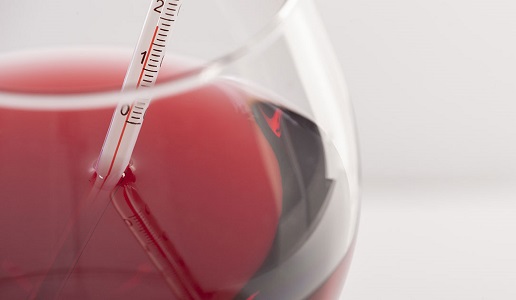Serving temperature

Knowing the proper serving temperature for a wine is not just a question of “showing off”. This is because temperature is what determines the way the organoleptic properties of a particular wine are perceived.
The serving temperature of a wine is a subject that, in my opinion, is not dealt with sufficiently and it is more important than one might think. Let me begin with a short explanatory story. Giorgio Grai, who was a famous Alto Adige winemaker and producer, was once invited by a restaurant to present two of his wines at an evening organized on his behalf. One was a Santa Maddalena and the other a Pinot Noir. Bad weather kept him from attending but he did send his wines, although due to a mistake only one made it there, the Santa Maddalena. The restaurateur was very worried about the mix up and phoned Grai who told him to relax. “Use two different glasses, one larger than the other, and in the smaller put some slightly chilled wine. In the end, the first will taste like a Santa Maddalena, which it is, while the other will seem like a Pinot Noir. No one will be able to tell the difference”. And, in the end, that is how it was.
In France, they often criticize Italians for drinking red wines when they are too warm and white wines when they are too cold. In many restaurants, the “room temperature” is not that of the wine cellar, as it should be, but that of the dining room, which is at least 10° higher. All this influences, as Grai himself explained, on the perception of a wine. In short, coolness exalts the acidity and makes the tannins seem harsher. Warmth, on the other hand, exalts the alcohol component and a wine’s softness. Cold numbs the taste buds and so, for example, drinking a Champagne that is too cold keeps you from sensing its organoleptic characteristics.
Then there is pairing to take into account. A wine that is too cold served with food that is very hot is never a good thing, unless you want to have a “Scottish shower” on your tongue and palate.
So what are the serving temperatures that one should abide by? Champagne should never be served below 6°C. A white wine should be served between 10 and 14°C, depending on how complex it is. An orange wine should be served at 14-16°C, because it has tannins that need to be a bit softened. The serving temperature for a red wine is between 14 and 16°C (which most wines are served at in Burgundy) and never over 20°C. For sweet wines, the serving temperature is between 6 and 10°C, a tad more for “oxidative” wines like Marsala. The more a wine has an expressive and complex aroma the higher the serving temperature should be. Attention should also be paid to alcohol content, which determines pseudo-caloric sensations. If a wine is very alcoholic, then it is best to serve it a bit cooler. A very bold red at no more than 16-18°C, for example.
What needs to be exalted is the correct rapport between hardness and softness, between the acidity and body, and the best expression possible of a wine’s bouquet. For sure one can play around as Grai did that time, and I’m sure that, in a blind tasting, if the same wine is successively served at different temperatures it would be very difficult to recognize it as the same wine. Try this out for yourselves.

 Italiano
Italiano






